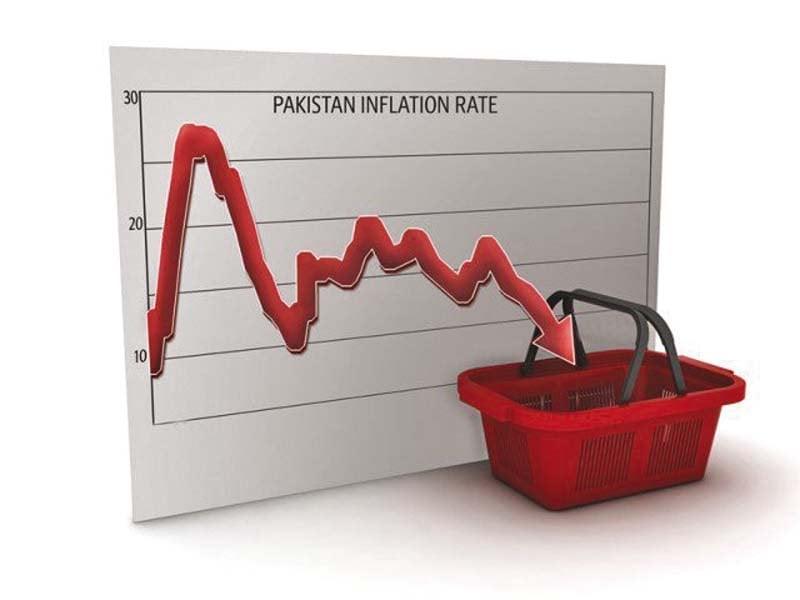ISLAMABAD:
The government said on Friday that inflation could slow further to 4% in December, a forecast that offers more room to reduce the interest rate to single digits and indicates that the annual target will be met.
In its monthly economic outlook, the Finance Ministry said there was considerable stability on the fiscal and external fronts, promising an “optimistic outlook.” Inflation is expected to remain within the range of 4-5% in December, according to the economic advisory wing of the Finance Ministry.
He said a nine percentage point reduction in the interest rate over the past six months was expected to stimulate economic activity.
If inflation falls to 4%, there will again be room to reduce the interest rate, which currently stands at 13%, by nine percentage points. Last month, inflation slowed to a 78-month low of 4.9%, according to the Finance Ministry.
The State Bank’s monetary policy committee decided to further cut the policy rate by two percentage points to 13%, effective December 17, 2024. Overall, the policy rate has been reduced by nine percentage points since June .
The decision is based on an inflation result in line with expectations, the stability of the fiscal and external sector, favorable global raw material prices and better growth prospects.
Reducing the interest rate will significantly reduce the cost of servicing the government’s debt and additional fiscal space can be used to make up for the revenue shortfall. On Friday, the Federal Board of Revenue (FBR) raised around Rs 5.07 trillion and needs to raise another Rs 940 billion in the remaining four days to meet IMF conditions.
The Finance Ministry said that on the external front, the hard-won stability was expected to continue on the back of remittances and export flows with decent imports. This will be complemented by exchange rate stability and contained inflation.
He added that better fiscal performance from July to October, driven by higher revenues and prudent spending management, was expected to create fiscal space for development spending and support sustainable economic growth.
According to the summary of fiscal operations, net federal revenue grew 72% to Rp 4.8 trillion. This growth was mainly driven by a sharp rise in non-tax collections due to the decision to book the central bank’s full-year fiscal profit of Rs 2.5 trillion in the first quarter.
Non-tax revenues doubled to Rp3.2 trillion in four months. However, expenses also remained high despite development spending coming to a near halt. The report showed that expenses grew 20.6% to Rp4.5 trillion in four months. In the last fiscal year, expenses amounted to Rs 3.7 trillion during the July-October period.
The Ministry of Finance said that Pakistan’s economy demonstrated sustained positive development from July to November, indicating an optimistic outlook for the current year.
Macroeconomic fundamentals have strengthened, marked by a further slowdown in CPI inflation with stable food prices, effective fiscal consolidation resulting in a fiscal surplus, a current account surplus supported by higher exports and remittances, and a accommodative monetary policy stance.
However, the large-scale manufacturing sector remains a problem area. In October, LSM recorded a marginal growth of 0.02%. The industrial sector suffered due to high interest rates, taxes and costs of doing business.
On a monthly basis, LSM decreased 2.2% in October, mainly due to a seasonal decline in the beverage sector, the Ministry of Finance said.
Drinks sector output has also been hit by unreasonable taxes despite warnings in June that the sector would crumble under the weight of higher taxes.
But the Finance Ministry said that as winter approached, demand for drinks typically decreased, leading to lower production. Overall, 12 of LSM’s 22 sectors performed positively during October, demonstrating resilience and continued growth in key industries, it added.
The ministry said the performance of the agriculture sector depended on rains, adding that for Rabi 2024-25, the government has set a wheat production target of 27.92 million tonnes in an area of 9.262 million hectares. To achieve this objective, concerted efforts are being made to ensure timely availability of essential inputs including agricultural credit, quality seeds, fertilizers and mechanization support.
The external account position has improved significantly, driven by a notable increase in exports and remittances despite rising imports. For the first five months, the current account posted a surplus of $944 million compared to a deficit of $1.7 billion last year.
In November alone, the current account recorded a surplus of $729 million, compared to a deficit of $148 million in November of last year. “This represents the fourth consecutive monthly surplus,” he added.




